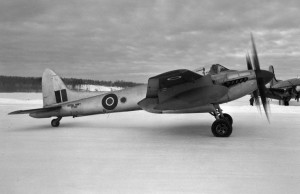This exciting project has recently been purchased by Pioneer Aero and it is our intention to restore it to flying condition. To this point we have focused the acquisition of parts and knowledge and it is envisaged this will continue before any physical work is undertaken.



,one of the most important missing FAA aircraft is set to return to life,would it not be nice to see repliicas in Yeovilton and the Mosquito museums,as well as see one fly.
The most beautiful aircraft ever built . What a project . You are to be commended to attempt such a difficult undertaking . I only wish I could be part of it ! The best of luck .
I was 11 years old and attending the Daily Express airshow at Hendon about 1951 and ‘planes were all new to me then. There was a FAA Sea Hornet in the static display – a F20 – It was simply the most beautiful piece of ironmongery I had ever seen through my young eyes. I remember looking at the complex compound curves of the main undercarriage doors and marvelling how they were formed to blend into that section of the engine nacelle. This must be one of the most iconic designs DH ever made and almost unbelievable that we should ever see one again. I wish you well in your project.
I wish you well in this so worthwhile project.
This one will take a while. All suffered wood rot early on, so have to be completely re-manufactured. It’s enough different from a Mosquito to make it a one-off. Fantastic aircraft that should be preserved. So sad that almost all were scrapped, so not even museum examples.
Hi Roger, yes it will take a while, if it was easy everyone would be doing it. I don’t think wood rot played any part in the Hornets demise, any structural issues were with the glue not rot.
Where are you now in the resteration of the Sea Hornet? Any ETA on when it will fly again?
No ETA for return to flight at this stage.
Stunning aircraft..have a look at my Flickr site for a photograph of a Sea Hornet in Plymouth Devon UK in the the early 1960s at a Civil Defence site.search for
“flickr/rac819”
Good luck with the project…my father served with 728 Squadron Fleet Air Arm at HalFar Malta..who flew Sea Hornets in the 1950s..the Squadron,not my father! He was an engineer..
I’m sure the DH Museum at London Colney have an engine and a bit of rear fuselage from a Hornet. I’m sure they’d part with the engine if it would help put TT193 in the air.
Hi,
I believe only 394 DH103 Hornets actually served in a number of roles. The last flying were with Spartan Air Services, mapping vast tracts of territory in Canada. If you are still looking for 4-blade DH propellers, have you considered 3D mapping and reinforced fibreglass? Not my specialist area, but please stay with this project. The most heart-ache beautiful aircraft I have ever seen. (Also the fastest twin-engine propeller a/c to serve in the RAF.)
Good luck!
Thanks Paul, we are thinking “outside the square” on several of the Hornet components propellers being one of these.
I don’t know if you are aware but the Midland Aircraft Recovery Group here in the UK have a Hornet/Sea Hornet cockpit canopy advertised as available on the British Aviation Archaeological Council web site – see http://www.aviationarchaeology.org.uk/surplus . I do not know when the information was posted but it might be worth checking if you need that part.
Good luck with the project.
Thanks David, we already have 2 NOS canopies in our large cache of spare parts. But will keep an eye on this.
I am a Kiwi living in Calgary and was aware that this aircraft had been used in this area after being sold off. It had been my impression that it was subsequently scrapped and I am thrilled to discover that rumours of its demise were somewhat exaggerated. I wish I had a line on parts for this beautiful and elegant aircraft, but all I can provide is my heartfelt best wishes in your endeavour to get this lovely plane back in the air.
Hi Carey, pretty sure there will be other Hornet parts around your area including engines and props, so if you get bored one day go searching, we would appreciate that.
Can anybody tell me – or motr particularly provide a photograph of the rear seat accommodation for the NF21 ? my measurement from scale drawings indicate that this must have been very cramped and extremely difficult to get into. All Hornets had a hatch in this location – used for access to the cameras and the radio. The canopy had no sun screen and would have been unpleasant from this point of view – as well as making the radar screen difficult to view. The tiny canopy was jettisionable but it would have been a difficult wriggle to get out of in a hurry. I worry about these things!
Hi David,
First of all stop worrying, there is currently no one who will be required to wriggle out of a flying Hornet any time soon. When we are building TT193 we will think about your concerns and see if we can remedy the problem.
How cool
Could you post a state of play progress report?
Thank you.